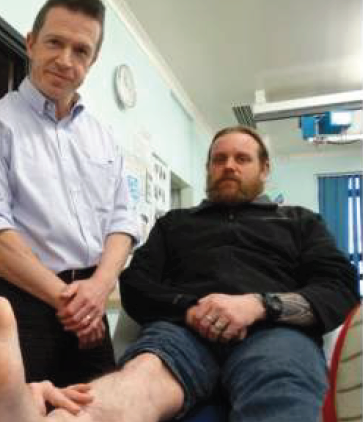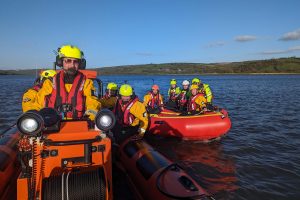
A TELEPHONE engineer from Carmarthen has praised a specialist hospital unit for enabling him to continue working following a motorcycle accident.
Rhodri Shailer, 44, was originally treated at another hospital after he broke his ankle in 2014, but unfortunately complications developed. A device used to help repair his ankle caused an infection in his shinbone, weakening it. His leg then gave way, resulting in a complex open fracture.
He was then treated at the Ortho-plastic Research Clinic at Morriston Hospital, which combines the skills of burns and plastic surgery consultants from the Welsh Centre for Burns and Plastic Surgery, with trauma and orthopaedic surgeons and physio and occupational therapists.
Victims of traffic collisions, accidents and even explosions receive highly specialist care which ranges from resetting open fractures and repairing complex wounds, to therapy to help restore their mobility as much as possible after their initial healing.
At Morriston, the infected part of Mr Shailer’s shin bone was taken away and then muscle was taken from another part of his leg to feed the blood supply to his healing bone (tibia), so it could knit together. Once that had healed, a rod was fitted from his knee to his ankle.
Mr Shailer said: “I had a motorcycle incident, which was repaired with an external fixator – which unfortunately there were issues with – and where the fixator went through the upper part of my leg, the bone broke.
“I was then brought to Morriston Hospital, with Professor Pallister’s team, where I had debridement, and a tibia nailing after the infection was removed from the bone.
“I found the treatment here second to none. I can’t give it enough praise. I’m a British telecom engineer, so I go up telegraph poles for a living, and need to have a good range of movement in my ankles and legs.
“I’ve been back in work now since May, but I’m still receiving therapy to help my range of movement still further.”
Consultant Orthopaedic Trauma surgeon, Professor Ian Pallister, said: “At Morriston Hospital we are in a unique position where we can offer an ortho-plastic service for patients who have sustained open fractures. These are complex injuries, usually as a result of traffic collisions, or sometimes in older patients, falls at home.
“These fractures break through the skin, causing a complex wound which is connected to the fracture. From a surgical point of view this requires surgical input to help stabilise the bones after cleaning the wound out, and plastic surgery to reconstruct the soft tissue. This often this requires moving muscle or skin and flesh around within the leg and even transferring it from different parts of the body in more complex injuries.”
He said that Morriston deals with around 50 open tibia fractures a year, as well as a number of open ankle and femur fractures.
“The surgery is only part of the story, and equally important is rehabilitating the patient afterwards, with physiotherapy; along with the input of our specialist nurses and occupational therapists for wound and a scar management, to help reduce swelling which enables the patient to regain their mobility.
“Bearing in mind the complexity of the problems and the fact that we look after patients from the whole of South Wales, patients often have to travel long distances, to come back for review here at Morriston.
“So we’ve set up this Ortho-plastic Research Clinic to cut down on the number of appointments and time patients have to spend travelling to and from us.
“But this also gives us the added benefit of being able to see the patient together – orthopaedic trauma specialists like myself, the plastic surgeons, specialist nurses, the occupational therapists and the physios.
“While we’re seeing the patient they are getting the benefit from the additional clinical input, and we’re also collecting information about their recovery. So as part of our research project so we can help define exactly what the crucial parameters are to help people get better quicker, and how to capitalise on that and develop the services,” he added.
“The support of the Joint Clinical Research Facility at Morriston Hospital with this has been indispensable.”


















Add Comment